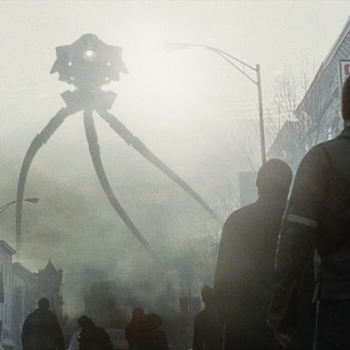
It’s the best and worst of times for Christian movies.
I can’t remember a year when more theatrical releases and television shows were made explicitly for Christian audiences. Growing up, we had to wait until our church got the latest from Billy Graham’s studios or head to the Christian bookstore to get the new “McGee and Me.” But this year alone, we’ve already seen two Jesus movies, a live passion play on network TV, a failed biblical drama series, and a “God’s Not Dead” sequel. And there’s more to come, whether it’s the big budget “Ben Hur” remake, the indie film “Last Days in the Desert,” or more of Pure Flix’s evangelical knock-offs releases.
But faith-based films have a reputation. They’re often poorly made, low-budget embarrassments. Sometimes, they’re actually offensive. And even when I like them — and I enjoyed both “Risen” and “The Young Messiah” — I often feel that my praise of “good” has to be followed by the qualifier “for what it is.”
Ideally, Christians would avoid these films. There is cinema that speaks to the soul; it just doesn’t always preach loudly or come packaged the way we expect. Films like “Calvary” and “The Tree of Life” have strengthened my spiritual walk as much as — sometimes more than — a sermon. Recent films like “Midnight Special” and even the ultra violent “Green Room” have challenged my thinking on issues of faith, parenthood and violence, even as some of them trouble me. A film doesn’t have to be explicitly about Christianity to prompt spiritual thought.
But I understand that some will always refuse to view art that isn’t made specifically for evangelical audiences. They view Christian entertainment as a safe place, free from content that offends or troubles them. While I find this outlook disconcerting — like Derek Webb, I think applying “Christian” to anything other than a person is just a marketing hook — I’m sympathetic. I grew up in a home where we were only allowed to listen to Christian music. My mom read “Left Behind.” I’ll fully admit that listening to Christian music as a teenager was meaningful because so much of it spoke directly to my circumstances; I didn’t feel alone. Sometimes you just want your art to reflect your experiences.
And I don’t think good art made for the Church is impossible. Films often are made for niche communities, and there are many thriving, vibrant cinematic subcultures; why can’t one of them be for Christians (ignoring, for a moment, that the underlying values in most films are Judeo-Christian)? I think films can be made that address the unique struggles and challenges Christians face and delve deeper into questions of faith, theological conversation and living in community. I hope there are young Christian filmmakers who feel called to write, direct and produce films that stir congregations and inspire believers. And if any are reading, here are five things I believe would help improve Christian cinema.
1. Commit to quality. We live in an age where anyone can make a movie, but that doesn’t mean everyone should. Christian directors, writers, producers and crafts people must learn to tell compelling stories with technical excellence. This isn’t a question of budget; I’ve seen independent films made for less than $1 million that are more beautiful and moving than a $150 million blockbuster. It’s about knowing the craft well enough to understand and work within your limitations. It’s about understanding film history and respecting the artists who have gone before; I wish directors of faith-based films understood cinematic grammar as well as they did theology and could quote from Scorsese, Hitchcock or Wilder just as often as they do Piper or Lewis. Before screenwriters insert the gospel into their scripts, they should learn proper plotting and effective dialogue. Directors should know how crucial camerawork and editing are to engaging viewers. Actors and filmmakers should work together to ensure that characters are fully developed, not just ciphers in a visual Chick tract. And Christian film making needs producers who are willing to support engaging stories and daring artistry, not simply run a film through theological proof-texting to push an agenda. I understand that Christian filmmakers feel they have an important message, but it will fall on deaf ears if they don’t respect the art form.

2. Explore familiar stories in new ways. There’s always trepidation when putting a Bible story to film. Stay too close to the text and you risk turning the film into nothing more than a moving flannelgraph depiction. Stray too far, and you risk offending believers. But I think the best biblical stories are the ones that take risks and find new ways to wrestle with Scriptures’ complex themes. “Noah” and “The Last Temptation of Christ” might be flawed in places, but they’ve also caused me to think more deeply about the stories I’ve heard all my life and see new truths buried inside. “Risen” found a new angle on the resurrection, while “The Young Messiah” brought fresh theological imagination to the Christ story. As with any literary adaptation, when filmmakers stick slavishly to the original text, the result is dry, staid and lifeless. Films that take risks and carefully depart from the familiar text often are the ones more interested in engaging with the story’s heart; they often feel more accurate to the original work than a beat-by-beat retelling, because they’re interested in the soul of a story, not just the plot points. We can sit and examine the narratives in church all we want; film offers us the opportunity to muse deeper on biblical themes and look anew at cherished stories.
3. Not every story should be a church/conversion story. If an unbeliever’s only exposure to Christianity was Christian art, they might conclude that Christians are insular people whose every waking thought has to do with church, conversion and the rapture. Nearly every story exists to nudge at least one character toward a conversion experience, and if that’s not the case, then there’s an explicit crisis of faith or a story of persecution. The exception here seems to be Christian Amish romance, which I still haven’t figured out the appeal of. But basically, there’s a very narrow formula, as if the lives of Christians only include their conversion, a faith crisis and the apocalypse. But our lives are so much more than the times we spend in church or encounter explicitly faith-driven challenges. Where are the stories of Christian marriages and the challenges they face? Where are movies about a Christian approach to sex — and not just one that says “not before marriage,” but that celebrates sex within marriage or discusses the awkwardness Christian culture has brought to it? Where is science fiction with a Christian background that doesn’t have to serve as allegory? How does a cop or soldier reconcile Christ’s commands to love our enemy with their daily job? What about the prophetic stories that call the church to account for its wrong actions in the world? What does the superhero story look like through a Christian lens? Christianity is not a political or moral movement, and it’s more than just a list of doctrinal points. I believe the Bible teaches that our faith is holistic and it touches and changes every aspect of our life. There are countless life experiences Christian art could touch; why just stick to the lowest hanging fruit?

4. Love every character. While I don’t know if it’s a great movie, Steve Taylor’s “Blue Like Jazz” was a refreshing antidote to the typical Christian movie. The story was a loose adaptation of Donald Millers memoir, and followed its character as he left his Christian subculture in Texas and joined the student body at Portland’s Reed College. There, he encountered liberal activists, atheists and lesbians. The film, however, is beautifully empathetic. Unlike “God’s Not Dead,” no atheists get their comeuppance. No one is preached at. There isn’t a single conversion scene. In fact, these unbelieving students are the catalysts for internal change and growth within Don. In most Christian films, however, nonbelievers are shown either as people who need to change or objects of temptation. Their identity is based only around whether or not they’re on the same side as the main character (and, implicitly, the audience), which I think also speaks to how we view nonbelievers. They’re sales targets, people who need to be saved, and we often look at them only in regard to their position to Christianity, not as people with real struggles, questions, joys and talents. The richest movies find humanity and shading in every character, even the antagonists. If our art is a picture of how well we’re heeding the words of Christ, then I fear we’ve missed a big command when it comes to loving our neighbors.
5. Acknowledge the messes. I’m not going to blame Christian movies for happy endings. They are, of course, the preferred way of ending all films where producers want to make a profit. And I’m not saying that there’s never a place for them. Some of the greatest cinematic endings of all time are uplifting ones. But if Christian filmmakers truly want to show what it looks like to wrestle with faith in the real world, then they need to embrace the messiness and pain that comes with it. I’ve said this before, but it’s cliche to have someone learn to trust God and then have him defeat the bad guy; I’m more interested in the story of someone who holds onto their faith even when it looks like evil’s won. I’m not interested in stories of happy families, successful marriages and perfect churches. I want art that examines divorce, strained relationships and schisms in congregations, because the gospel exists to help us navigate the pain in those places. I don’t want my art to tell me we’re doing great or that we’re going to win. I want it to give me something to keep my eyes on when I lose. Christians believe our faith can plumb the depths of our lives. The greatest respect we can pay it and the deepest beauty we can find is when we allow our art to do just that.












